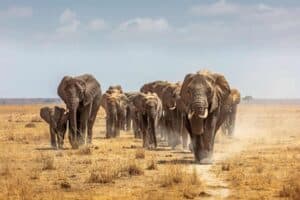Guests received an unexpected surprise during lunchtime at the Elephant Sanctuary near Hartebeespoort Dam recently.

A male elephant sauntered towards his female counterpart at their enclosure near a watering hole. Those who had come to the sanctuary for interactions with the elephants quickly noticed that the male was trying to sweet-talk the female elephant to engage in some sort of activity with him.
The female was having none of it and gently moved away from the advances of the male.
“She is playing hard to get,” shouted a member of our party. Later on, it seemed that the female elephant had come around and returned to the male, but he was having none of it, fuelling a battle of the sexes discussion among those in attendance.
Relations aside, the sanctuary is an interesting place and it is close enough for Johannesburg folks to enjoy a bit of the bush with some friendly, domesticated elephants. During the feeding, the elephants were unfazed by the presence of humans and seemed to enjoy the interactions.
Visitors behaved and avoided sudden movements (as per the guide’s instructions) and all cellphones had to be switched off. Although they may be perturbed by mobile phones, the elephants seemed quite happy to pose for pictures with visitors.
The guide, ironically named Simba, informed the gathered contingent that the elephants were domesticated through positive reinforcement animal management principles, and as a result, provide us with the unique opportunity to interact with them. Visitors were taken on a journey into the world of the African elephant and were guided through an unforgettable expe-rience with these magnificent creatures.
It is said that this particular sanctuary is unique in that it offers visitors the incredible opportunity to walk hand-in-trunk with the elephants. Although we were not so fortunate to experience this, the sanctuary also offers e-lephant back riding. Apparently bare-back elephant riding enables humans to feel the power and bulk of an elephant in contrast with the quietness, delicateness and grace of these mammoth creatures’ movement as they walk and glide across the ground. At one point the guides were training a certain elephant and referred to it with a human name.
It was quite astonishing when the elephant responded to orders.
The sanctuary also offers accommodation should guests feel the need to sleep over and take in the daily routines that the e-lephants go through from the morning until dusk. And the on-site curio shop offers wonderful delights at reasonable prices.
Some weighty facts
- The elephant’s foot is constructed in such a way that the animal is virtually walking on tiptoe, with a tough, fatty pad of connective tissue forming the sole.
- Elephants tusks are overgrown incisors protruding from the upper jaw. They grow at a rate of 15-18cm a year, depending on their diet.
- Jan van Riebeeck’s first mention of ivory in his journal is a record of three tusks bartered from Hottentot hunters for 250g of tobacco.
- The skeletal frame of an elephant allows the animal to stand upright on its hind legs.
- Elephants wear down six sets of molars in a lifetime.
- Elephant herds consist of females, who are usually related, calves and young bull calves. The eldest female, called the matriarch, most often leads the herd.
- Bull calves get kicked out of the herd when they reach 12 years of age to join the bull “bachelor” herds or to become a solitary bull. Bull herds will only join a female herd when it is mating season, or at a waterhole.
- The average speed for charging elephants is about 35-40km per hour.
- A calf will only learn how to use its trunk properly at about six months of age.
- Elephants are known to display a deep sensitivity and awareness of death and will return repeatedly to carcasses and skeletons of deceased herd members, running their trunks gently over their remains as though paying their respects.
- Elephants spend as many as 18-20 hours a day feeding and drinking.
- An elephant generally sleeps for only three or four hours a day. Occasionally they may lie down for an hour or so, but they mostly take short, cumulative naps, usually standing upright or leaning against a tree or termite mound.
- A fully grown adult bull’s tusks can extend to 3m and weigh as much as 100kg each. The heaviest recorded tusk weighed 102.7kg.






